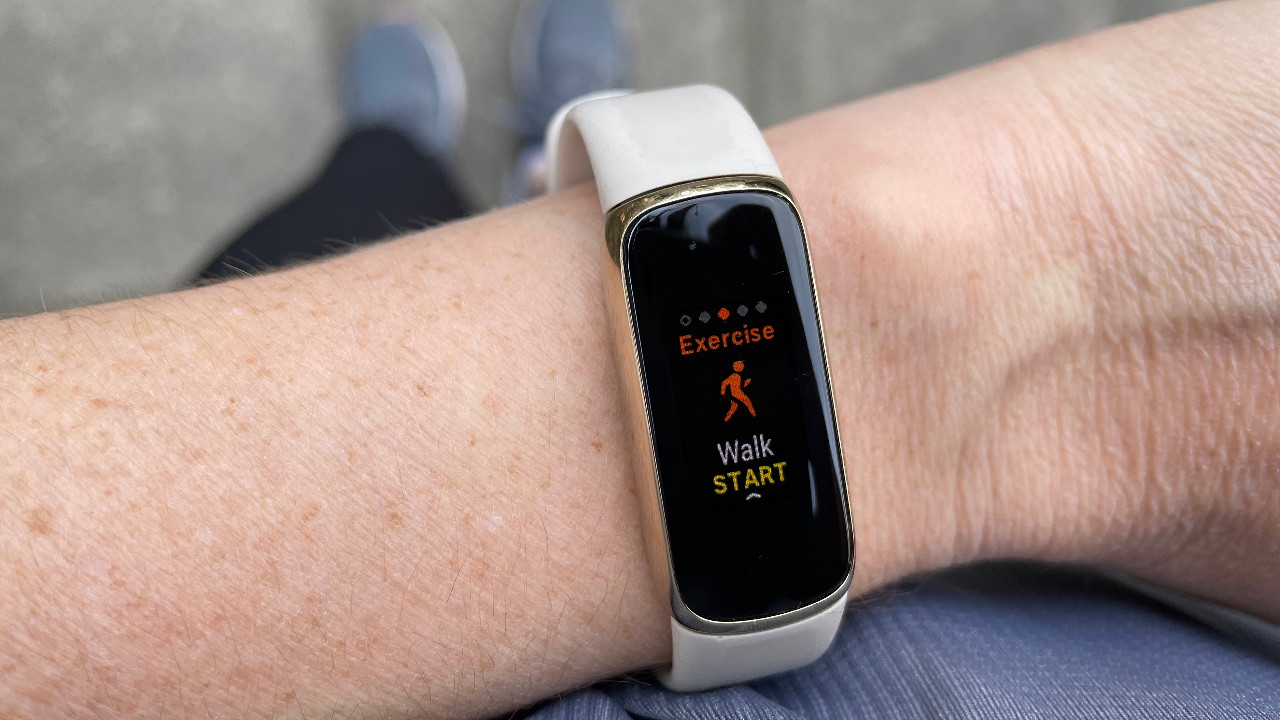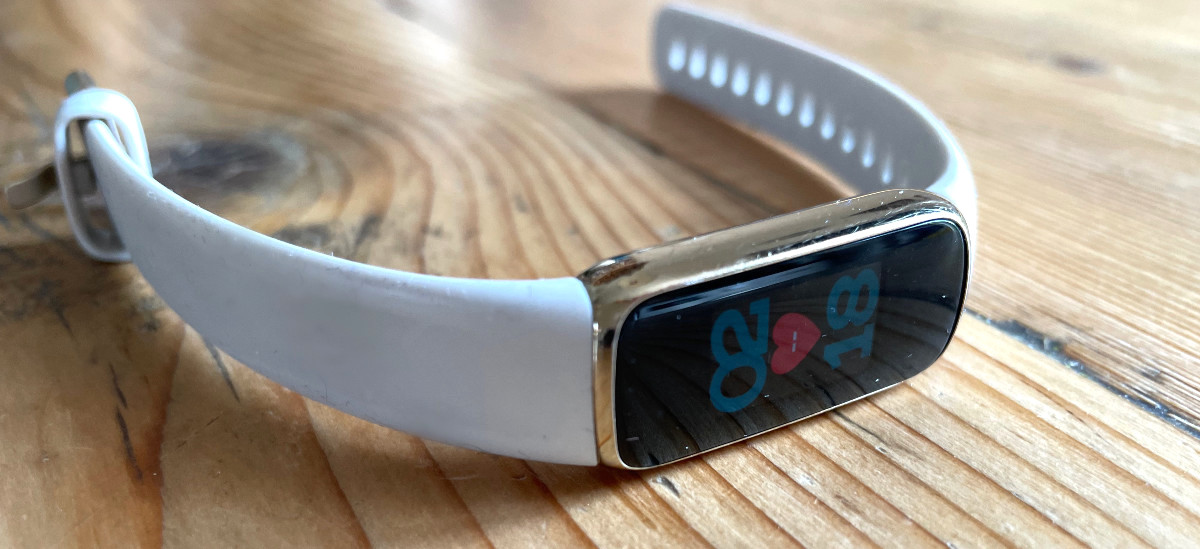Our Verdict
This is a useful device for keeping tabs on your general activity and sleep, and it’s far more stylish than a typical tracker. However, it doesn’t measure up as an exercise tracker and Fitbit Premium can go overboard on the data.
For
- Stylish
- Easy to use
- Helps to form healthier habits
Against
- Small, hard-to-read screen
- Lacks on-board GPS
- Fitbit Premium provides too much data
You can trust Coach
The Fitbit Luxe is a watch I might actually choose to wear every day. This stylish-looking, classy device is a far cry from the moulded rubbery lumps typical of most fitness bands. It has a slim, rounded watch face in a stainless steel case and a comfortable silicone strap with a buckle to match the case. If that’s not stylish enough, you also have the option of swapping the strap for a link bracelet by Californian jewellery brand Gorjana (sold separately, £89.99, pictured below).
The Luxe is often reduced in sales, so if you're considering buying one it's well worth checking the Black Friday Fitbit deals page in November, and Amazon Prime Day Fitbit deals in July and October.

The Fitbit Luxe is incredibly easy to set up and pair with the app. The AMOLED colour screen is bright and clear—although smaller than it appears to be at first. There are no buttons, but it’s easy to navigate with swipes and taps; however, it did take me a while to get the hang of the “two firm taps” needed to activate the water lock for use in the shower.
Basic data is visible on the Luxe at the swipe of a finger: heart rate, steps taken, distance covered, and Active Zone Minutes (when your heart rate is high enough to count as cardio) for the current day. The app, on the other hand, offers a huge amount of detailed info about exercise, stress levels, heart rate data, sleep and more.
Some data is available only to Fitbit Premium subscribers though, such as advanced sleep analytics, guided programmes, wellness reports, mindfulness sessions, video workouts and challenges. Access to Premium is free for the first six months – enough time to try out these features and see how much you use them before deciding whether to fork out £7.99 a month (or £79.99 a year, which works out to £6.67 a month).

See related
Although the Luxe contains a SpO2 sensor, not all the corresponding features were available when I was reviewing it. Current and resting heart rate info seems accurate when compared with other heart rate trackers, but there’s no way to see previous heart rate data on the watch itself – it’s visible only in the app.
You can choose from an array of watch face styles through the app. Some display heart rate data on the main screen, others step count. Phone notifications also pop up on the watch, although I found them tiny and hard to read. You also get emails congratulating you on reaching certain step-count milestones – for instance, when you’ve racked up a step count equalling a marathon – making it feel like an achievement.
Sign up for workout ideas, training advice, reviews of the latest gear and more.
The Luxe’s battery lasts three to five days depending on how much you use the activity tracking features. You’ll receive helpful notifications on the watch, as well as emails, reminding you to recharge when the battery is low.
Exercise Tracking
The Luxe can track specific exercise sessions: a walk, run, bike, swim and so on (up to six exercise types from a list of 20 in the app). You can either just press start to record your session or you can set a goal, exercising for a certain number of zone minutes, time, calories burned or distance, depending on the activity. During a run the device can show you your pace, time elapsed and distance, and with single taps of the touchscreen you can see more data such as current heart rate, Active Zone minutes, average pace, calories burned and steps taken. Swiping up on the screen will give you the option to pause or finish your workout.
The Luxe doesn’t have built-in GPS tracking, but it can use your phone’s location to offer more accurate distance and speed tracking when walking, running or cycling outdoors. It also has a SmartTrack feature, which I really like – it will recognise activities like running for a bus and will log this as part of your daily exercise. While running you can switch on a useful auto-pause feature which meant I no longer forgot to restart my running watch after a short wait at the traffic lights. It also means that speed stats apply only to time spent actually moving, which is a bonus.

Sleep Tracking
Switch on “sleep mode” and you won’t be disturbed by notifications or arm movements waking the screen. I found the sensor lights against my wrist were not too bright and although I don’t normally wear a watch at night I wasn’t bothered by the device. I found that the sleep tracking feature was remarkably accurate, with the exception of one instance when it mistakenly logged me as asleep one afternoon while I was lying on the sofa reading.
There’s a vast amount of sleep data available, although most of the in-depth analysis is reserved for Premium subscribers. For sleep periods longer than three hours, all users can see a sleep score, when you fell asleep and woke up, and an analysis of your deep sleep and REM. A restoration score will give you an idea of how restful your sleep was.
Premium subscribers receive a lot more information. The app analyses your night’s sleep, showing time asleep versus awake as well as time in deep sleep and REM, with graphs detailing your journey through the stages. As well as showing percentages in each sleep stage for individual days, it displays your 30-day average, and a benchmark range for men or women your age.
There’s even more data for Premium subscribers in the Restoration section. A graph details your sleeping heart rate against your average resting heart rate while a Restlessness percentage tells you how much you toss and turn during the night. You’ll also find an Estimated Oxygen Variation graph that shows how much your blood oxygen levels fluctuate during the night. According to the app, high variations in oxygen saturation can indicate breathing issues.
Health Metrics
A health metrics section opens a door to yet more data including heart rate variability while asleep. A higher degree of variability can indicate that you’re in good health, while a drop in HRV might indicate stress or illness. Your breathing rate while asleep is a similar indicator of general health. Personal baselines are calculated over a 30-day period, allowing you to see at a glance when your stats start heading out of your normal range.
Health metrics also track your resting heart rate, which can be a good indicator of fitness level and general health, and your skin temperature at night, taken at your wrist. According to the app, swings in skin temperature may indicate that you’re getting a fever, but it’s more likely to mean your bedroom is warmer than usual or that you had your arm under the duvet. I am, however, dubious about the need for some of these health stats – it can seem like the device is collecting data for the sake of having as much information as possible.
Another Premium feature is the ability to generate a Wellness report, showing overviews of heart rate, weight, activity, sleep and logged menstrual cycles. According to Fitbit, the idea is that you can share it with your doctor as a starting point for discussion about your general health. The longer you wear the device, the more interesting the data becomes, with trends shown over the past 30 days, three months, six months and a year. Using this information you can gain longer-term insights into your health, such as how the amount and intensity of the activity you’re doing affects your fitness levels and the quality of your sleep.
Menstrual Health Tracking
By entering the date of your last period the app offers an easy and accessible way to keep track of your cycle. You can also enter symptoms and other data in the app if you want to keep a more detailed log. Once it has this information, the Luxe will show you at a glance where you are in relation to your fertile window and your next period.
Stress And Mindfulness
The app has a stress management section that uses your sleep data, health metrics and daily exertion to give you a stress management score out of 100. You can also log how you are feeling, from very calm to very stressed.
There’s a meditation or Relax function within the watch as well. Start a session and you are guided to “follow the circle” with your breathing, inhaling and exhaling as the circle increases and decreases for the suggested two minutes – although you can set it for any amount of time between one and 10 minutes. Your breathing rate is estimated through heart rate micro-variations captured through the device. I did find watching the little circle hypnotic, but any relaxing effect from the deep breathing was negated when, to my annoyance, the device concluded my alignment was low.
Premium subscribers can also access a library of mindfulness videos in the app, from guided meditations to help with stress and sleep issues, to meditation videos from alternative medicine guru Deepak Chopra.
Is The Fitbit Luxe Worth It?
I’ve been wearing the Luxe for a month and have found it an easy and accurate way to track my daily activity. It has definitely encouraged me to be more active and I’ve headed out running or cycling more often than I might have. When running errands, I’ve also pushed myself that little bit more to raise my heart rate into an Active Zone. Fitbit’s step achievement badges and congratulatory messages are also subtly addictive, although I did turn off the hourly notifications to get up and move around, which I found irritating (and sometimes it just gave me an excuse to go to the kitchen in search of chocolate biscuits).
The Luxe has, in addition, made me more conscious of my habits by showing me when I’m falling short of expected goals and when I’ve been more active than I had thought. The sleep tracking feature has also helped me make small changes to increase my hours of good-quality shut-eye.
Although the sleep tracking and health metrics analytics are interesting, I found I was overloaded with data. I certainly don’t need that level of detail every day and plan to opt out of Premium once the free six months is up. It would be easy to get bogged down by the scores and ratings awarded by the app in every possible area. No-one wants to lose sleep over their sleep score or feel stressed because their Fitbit has given them a low stress management score.
As a keen runner, I found the Luxe didn’t quite cut it as a sports watch, and not only because of the lack of on-board GPS. While running or cycling it’s hard to see what’s displayed on the small screen, especially in bright sunshine. The screen doesn’t show all the relevant info at once and tapping and swiping isn’t easy when you’re on the move and your fingers are sweaty. After several attempts to check the time mid-run, I eventually gave up and pulled out my phone. Stopping and starting is undoubtedly easier and more accurate with a button than with a tiny touchscreen.
The Luxe is not a smartwatch and it’s not a running watch, but it is a stylish little tracker for those who could use a little encouragement to live a more active lifestyle.

Camilla Artault is a writer and keen runner. She has covered women’s running gear – testing leggings, jackets, running bras, tops and shorts – for Coach since 2018, as well as interviewing experts and writing about a range of health and lifestyle topics.

